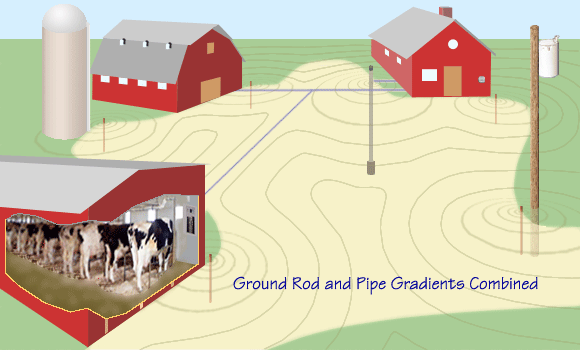Combined Utilization-Side Gradients |
|
|
|
As we have learned, there are many types of metallic objects around a farmstead that work as grounding
electrodes. They come in a variety of shapes, sizes, and materials. Some of the utilization-side neutral return current turns into earth current as it flows to and from the earth
through these grounding electrodes. In so doing, these earth currents create voltage gradients
on the surface of the earth. These gradients are mostly of the spreading type, as
we have seen in the previous two sections. Gradients from different objects superimpose
onto each other, yielding a pattern similar to that outlined below. |

|
 
|
|
The resulting gradient for any particular farmstead has a complex and variable shape.
The final pattern incorporates features caused by both the ground rods
and the pipes. The dominant feature at any one point depends on the relative
strength of the component gradients at that point. Since the amount of current determines the voltage gradient strength and
this amount can vary, the resulting gradient pattern will change dynamically with the
changing of currents flowing through these electrodes. |
|
Although currents determine the strength of these voltage gradients and their variation over time, it is the size, shape and layout of the
grounding electrodes that characterizes the basic
pattern of the overall gradient around a farmstead.
|
|
The overall pattern will be similar to that shown in the illustration above.
This pattern will warp and change much like the lines on a weather map
showing air mass movements. Unlike the weather map, these voltage gradient distortions
will gyrate around fixed points and lines that are set by the locations of the grounding electrodes. |
|
|





|
